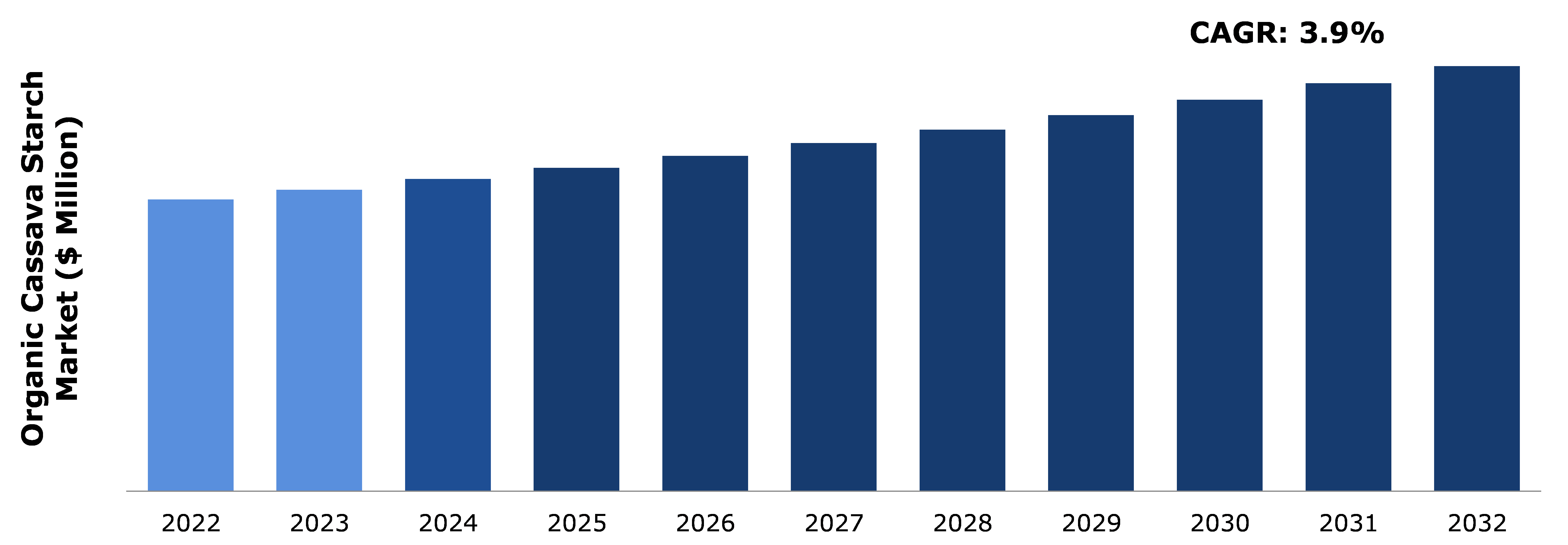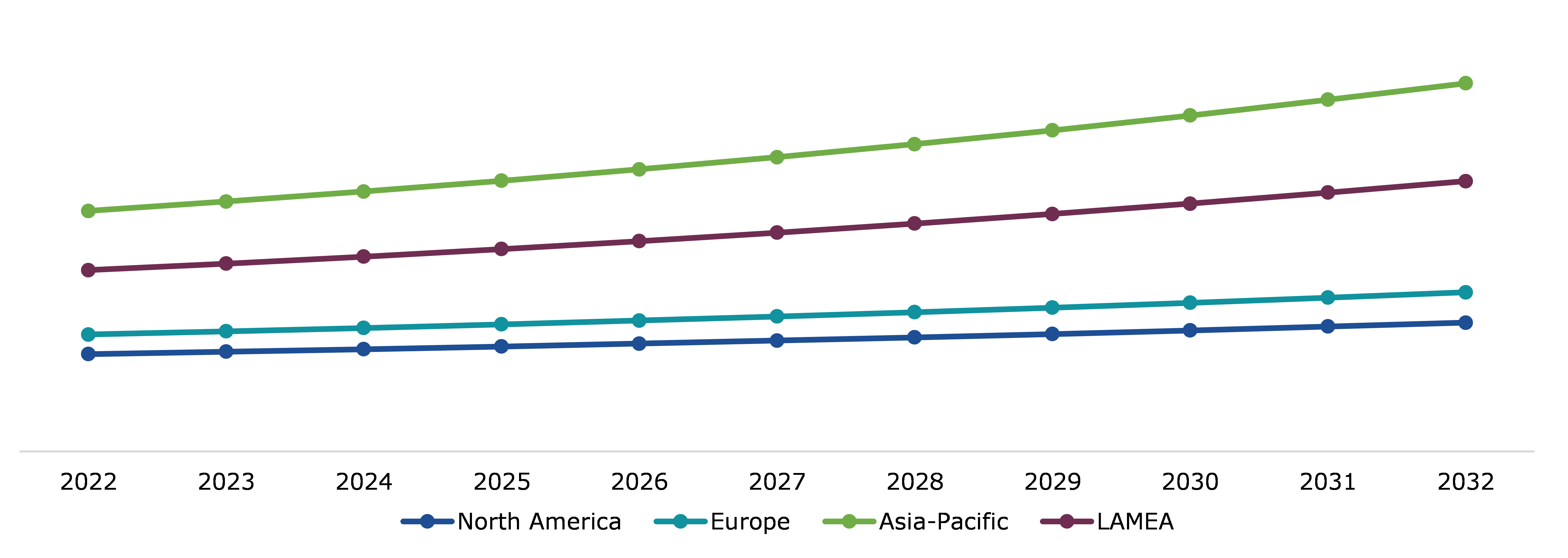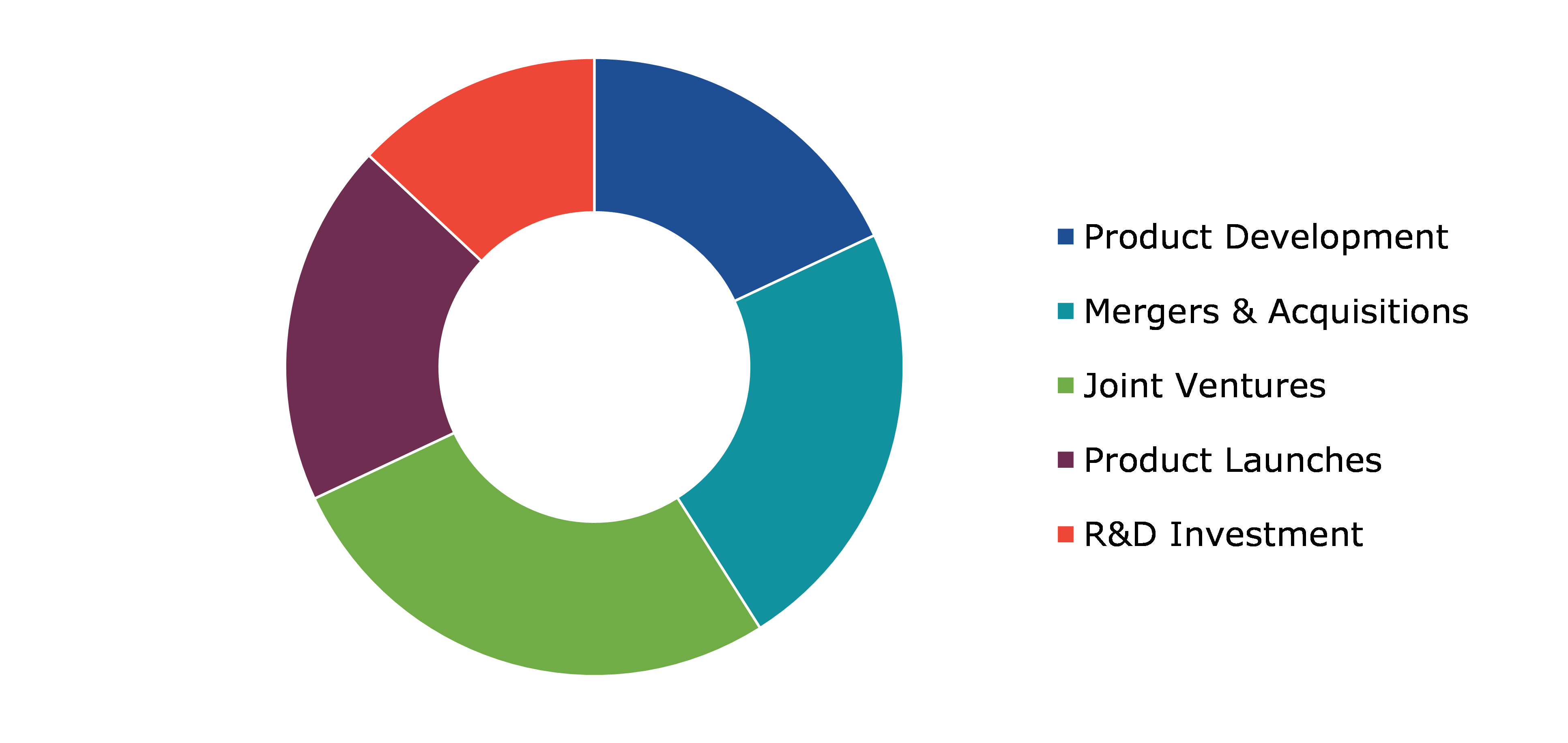Organic Cassava Starch Market Report
RA09216
Organic Cassava Starch Market by Type (Native and Pre-gelatinized), End-use Industry (Food Processing, Textile, Chemical and Pharmaceutical, and Others), and Region (North America, Europe, Asia-Pacific, and LAMEA): Global Opportunity Analysis and Industry Forecast, 2023-2032
Organic Cassava Starch Overview
Cassava, a versatile root vegetable consumed by millions worldwide, is the source of various essential products, including cassava starch. Organic cassava starch is derived from the starchy component of the cassava root through a meticulous process of extraction, excluding fibrous materials and water. This organic variant is cultivated without the use of synthetic pesticides or fertilizers, aligning with the principles of organic farming. The production of organic cassava starch involves washing, drying, and grinding, resulting in a highly refined and pure starch characterized by its neutral taste and potent thickening power. Organic cassava starch is also known as tapioca starch. This organic derivative serves as a fundamental ingredient in a variety of processed foods, showcasing its versatility in both sweet and savory culinary applications.
In the food industry, organic cassava starch finds diverse applications, primarily as a thickener and stabilizer. Its unique characteristic of contributing minimal flavor to food items enhances the taste of food. Furthermore, cassava starch is also widely used in the paper manufacturing and textile industries in paints, glues, industrial alcohols, soaps, bleaches, explosives, and others. Thus, organic cassava starch emerges as a refined and versatile organic ingredient with wide-ranging applications in both culinary and industrial domains. Its extraction from cassava roots, along with adherence to organic farming practices, positions it as a desirable choice for those seeking natural and sustainable solutions in their food and manufacturing processes.
Global Organic Cassava Starch Market Analysis
The global organic cassava starch market size was $2,985.5 million in 2022 and is predicted to grow with a CAGR of 3.9%, by generating a revenue of $4,349.6 million by 2032.
Source: Research Dive Analysis
Growing Demand for Starch-based Products and Economic Viability of Cassava Starch to Drive Market Growth
One of the primary drivers for organic cassava starch is its growing demand due to factors such as availability, low-cost, and unique functional features. The organic variant of cassava starch, cultivated without synthetic pesticides or fertilizers, aligns with the rising consumer preference for organic and sustainable products. The economical cultivation practices of cassava, along with its resilience to adverse conditions such as drought, contribute to its affordability. This makes organic cassava starch an economically viable choice for both consumers and manufacturers.
The surge in demand for health-promoting starch-based ingredients boosts the organic cassava starch demand. Chemical treatments, a common technique for modification, are employed to enhance cassava starch functionalities, particularly in creating resistant starch with numerous health benefits. The ability to increase resistant starch content and reduce digestibility rates through chemical modification positions organic cassava starch as a valuable ingredient catering to health-conscious consumers. This aligns with the broader trend in the food industry toward developing functional and health-oriented products. These factors are anticipated to boost the organic cassava starch market share in the upcoming years.
Allergic Reaction and Potential Cyanide Content to Restrain the Market Growth
One of the significant restraints associated with organic cassava starch revolves around the potential cyanide content when the cassava is not prepared properly. While properly prepared cassava is considered likely safe for occasional consumption in normal food amounts, improper preparation may result in the presence of chemicals that can be converted to cyanide in the body. Cyanide poisoning can cause certain paralysis conditions. This risk is increased, especially if cassava is consumed as part of a low-protein diet. Therefore, the need for meticulous processing and preparation becomes a critical restraint for the widespread adoption of cassava starch, particularly in regions where traditional processing methods may not be followed consistently.
In addition, in some individuals, the consumption of cassava, including its derivative, organic cassava starch, can trigger allergic reactions. Allergic responses to cassava can lead to mild discomfort to severe reactions. This poses a restraint as it limits the accessibility and acceptance of cassava starch among individuals with known cassava allergies, thereby affecting the organic cassava starch market growth in the upcoming years.
Biobased Innovations and Sustainability Initiatives to Drive Excellent Opportunities
The breakthrough innovations are projected to drive the organic cassava industry growth and sustainability. Cassava emerges as a robust biomaterial, offering a sustainable solution for resource-efficient utilization and a green environment. This presents an opportunity for organic cassava starch to play a pivotal role in innovative industrial applications such as water treatment agents, oil drilling materials, industrial alcohols, combustibles, paints, and others. The growing emphasis on biobased innovations such as the development of novel cassava biomaterials, particularly those that are low-cost and unexploited, aligns with the trajectory of sustainable biobased industries.
The integration of sustainable processes opens opportunities to reduce waste streams, guarantee zero carbon footprints, thereby enhancing sustainability. In addition, the production of organic cassava starch leads to a renewable and versatile biomass supply chain. Thus, the use of cassava starch for industrial feedstocks contributes to the development of sustainable biorefineries feedstocks that do not compete with food and feed supply. These factors are anticipated to drive the organic cassava starch market expansion during the forecast period.
Global Organic Cassava Starch Market Share, by Type, 2022
Source: Research Dive Analysis
The native sub-segment accounted for the highest market share in 2022. Native cassava starch is derived from cassava, a tropical root crop known for its high starch content. Cassava is abundant, widely cultivated, and economically viable, making native cassava starch a cost-effective raw material. In addition, native cassava plants are resilient to various environmental conditions, enabling year-round cultivation. This ensures a consistent and uninterrupted supply of cassava roots for starch extraction thereby making it a reliable source. In addition, native cassava starch finds applications across various industries such as food, paper, textile, adhesive, pharmaceutical, and biofuel production.
The versatility of native organic cassava arises from its ability to serve as a thickening agent, stabilizer, and binder in food products, as well as its suitability for industrial processes. Also, the native cassava starch exhibits favorable functional properties such as high paste viscosity, clarity, shear resistance, and freeze-thaw stability. These properties make it a preferred choice in the formulation of food products, where these characteristics contribute to the desired texture and quality. These factors are anticipated to boost the demand for native cassava starch type segment in the upcoming years.
Global Organic Cassava Starch Market Share, by End-use Industry, 2022
Source: Research Dive Analysis
The food processing sub-segment accounted for the highest market share in 2022. The abundant production of cassava across several countries, positions cassava as a staple food. In addition, organic cassava starch is used in various food products, such as cookies, cheese sticks, noodles, soups, sauces, canned fruits, and others. Also, organic cassava starch, derived from cassava, can be incorporated into formulations to modify the texture and enhance the nutritional profile of these products.
Furthermore, organic cassava starch can be used to create doughnuts, replacing traditional wheat flour. In countries such as Indonesia, Thailand, and others, the popularity of modified cassava flour (mocaf) in food products is rising, offering a gluten-free alternative to imported wheat flour. Thus, the integration of organic cassava starch into food processing not only contributes to enhanced nutritional profiles but also aligns with the growing demand for gluten-free and sustainable food alternatives.
Global Organic Cassava Starch Market Size & Forecast, by Region, 2022-2032 ($Million)
Source: Research Dive Analysis
The Asia-Pacific organic cassava starch market generated the highest revenue in 2022. The demand for organic cassava starch in Asia-Pacific countries is influenced by several key factors, reflecting the region's significant role in cassava production, trade, and processing. Asia-Pacific countries, particularly Thailand and Vietnam, are major contributors to global cassava production. Thailand, being the largest tapioca starch producer, drives demand for cassava starch due to its extensive application in various industries.
The substantial export activities in Asia-Pacific, notably from Thailand and Vietnam, contribute to the demand for organic cassava starch. For instance, in 2021, Thailand exported $1.64 billion worth cassava starch. In addition, Vietnam is another key exporter of cassava starch which demonstrates the growing market for cassava products. The increasing export volume, along with expanding markets like Taipei and Malaysia, signifies the rising demand. This growth prompts the cassava industry to explore value-added products like organic cassava starch to cater to diverse market preferences. These factors are anticipated to drive the Asia-Pacific organic cassava starch market growth in the upcoming years.
Competitive Scenario in the Global Organic Cassava Starch Market
Partnership and business expansion are common strategies followed by major market players. For instance, in January 2024, Niger Delta Development Commission (NDDC), a federal government agency, announced plans to establish a partnership with an indigenous cassava starch manufacturing factory in Sagbama Local Government Area of Bayelsa State to create job opportunities for the youths.
Source: Research Dive Analysis
Some of the leading organic cassava starch market players are Tate & Lyle, Cargill, Incorporated, Ingredion, Visco Starch, Global Sweeteners Holdings Ltd, Psaltry International Company Limited, Ekta International, Chorchaiwat Industry Co. Ltd., Matna Foods Ltd., and ADM.
| Aspect | Particulars |
| Historical Market Estimations | 2020-2021 |
| Base Year for Market Estimation | 2022 |
| Forecast Timeline for Market Projection | 2023-2032 |
| Geographical Scope | North America, Europe, Asia-Pacific, and LAMEA |
| Segmentation by Type |
|
| Segmentation by End-use Industry |
|
| Key Companies Profiled |
|
Q1. What is the size of the global organic cassava starch market?
A. The size of the global organic cassava starch market was $2,985.4 million in 2022 and is projected to reach $4,349.6 million by 2032.
Q2. Which are the major companies in the organic cassava starch market?
A. ADM, Tate & Lyle, and Cargill, Incorporated are some of the key players in the global organic cassava starch market.
Q3. Which region, among others, possesses greater investment opportunities in the future?
A. Asia-Pacific possesses great investment opportunities for investors in the future.
Q4. What will be the growth rate of the Asia-Pacific organic cassava starch market?
A. The Asia-Pacific organic cassava starch market is anticipated to grow at 4.4% CAGR during the forecast period.
Q5. What are the strategies opted by the leading players in this market?
A. Partnership and business expansion are the two key strategies opted by the operating companies in this market.
Q6. Which companies are investing more on R&D practices?
A. Ingredion, Visco Starch, and Global Sweeteners Holdings Ltd are the companies investing more on R&D activities for developing new products and technologies.
1. Research Methodology
1.1. Desk Research
1.2. Real time insights and validation
1.3. Forecast model
1.4. Assumptions and forecast parameters
1.5. Market size estimation
1.5.1. Top-down approach
1.5.2. Bottom-up approach
2. Report Scope
2.1. Market definition
2.2. Key objectives of the study
2.3. Market segmentation
3. Executive Summary
4. Market Overview
4.1. Introduction
4.2. Growth impact forces
4.2.1. Drivers
4.2.2. Restraints
4.2.3. Opportunities
4.3. Market value chain analysis
4.3.1. List of raw material suppliers
4.3.2. List of manufacturers
4.3.3. List of distributors
4.4. Innovation & sustainability matrices
4.4.1. Technology matrix
4.4.2. Regulatory matrix
4.5. Porter’s five forces analysis
4.5.1. Bargaining power of suppliers
4.5.2. Bargaining power of consumers
4.5.3. Threat of substitutes
4.5.4. Threat of new entrants
4.5.5. Competitive Rivalry Intensity
4.6. PESTLE analysis
4.6.1. Political
4.6.2. Economical
4.6.3. Social
4.6.4. Technological
4.6.5. Legal
4.6.6. Environmental
4.7. Impact of COVID-19 on organic cassava starch market
4.7.1. Pre-covid market scenario
4.7.2. Post-covid market scenario
5. Organic Cassava Starch Market Analysis, by Type
5.1. Overview
5.2. Native
5.2.1. Definition, key trends, growth factors, and opportunities
5.2.2. Market size analysis, by region, 2022-2032
5.2.3. Market share analysis, by country, 2022-2032
5.3. Pre-gelatinized
5.3.1. Definition, key trends, growth factors, and opportunities
5.3.2. Market size analysis, by region, 2022-2032
5.3.3. Market share analysis, by country, 2022-2032
5.4. Research Dive Exclusive Insights
5.4.1. Market attractiveness
5.4.2. Competition heatmap
6. Organic Cassava Starch Market Analysis, by End-use Industry
6.1. Overview
6.2. Food Processing
6.2.1. Definition, key trends, growth factors, and opportunities
6.2.2. Market size analysis, by region, 2022-2032
6.2.3. Market share analysis, by country, 2022-2032
6.3. Textile
6.3.1. Definition, key trends, growth factors, and opportunities
6.3.2. Market size analysis, by region, 2022-2032
6.3.3. Market share analysis, by country, 2022-2032
6.4. Chemical and Pharmaceutical
6.4.1. Definition, key trends, growth factors, and opportunities
6.4.2. Market size analysis, by region, 2022-2032
6.4.3. Market share analysis, by country, 2022-2032
6.5. Others
6.5.1. Definition, key trends, growth factors, and opportunities
6.5.2. Market size analysis, by region, 2022-2032
6.5.3. Market share analysis, by country, 2022-2032
6.6. Research Dive Exclusive Insights
6.6.1. Market attractiveness
6.6.2. Competition heatmap
7. Organic cassava starch Market, by Region
7.1. North America
7.1.1. U.S.
7.1.1.1. Market size analysis, by Type, 2022-2032
7.1.1.2. Market size analysis, by End-use Industry, 2022-2032
7.1.2. Canada
7.1.2.1. Market size analysis, by Type, 2022-2032
7.1.2.2. Market size analysis, by End-use Industry, 2022-2032
7.1.3. Mexico
7.1.3.1. Market size analysis, by Type, 2022-2032
7.1.3.2. Market size analysis, by End-use Industry, 2022-2032
7.1.4. Research Dive Exclusive Insights
7.1.4.1. Market attractiveness
7.1.4.2. Competition heatmap
7.2. Europe
7.2.1. Germany
7.2.1.1. Market size analysis, by Type, 2022-2032
7.2.1.2. Market size analysis, by End-use Industry, 2022-2032
7.2.2. UK
7.2.2.1. Market size analysis, by Type, 2022-2032
7.2.2.2. Market size analysis, by End-use Industry, 2022-2032
7.2.3. France
7.2.3.1. Market size analysis, by Type, 2022-2032
7.2.3.2. Market size analysis, by End-use Industry, 2022-2032
7.2.4. Netherlands
7.2.4.1. Market size analysis, by Type, 2022-2032
7.2.4.2. Market size analysis, by End-use Industry, 2022-2032
7.2.5. Italy
7.2.5.1. Market size analysis, by Type, 2022-2032
7.2.5.2. Market size analysis, by End-use Industry, 2022-2032
7.2.6. Rest of Europe
7.2.6.1. Market size analysis, by Type, 2022-2032
7.2.6.2. Market size analysis, by End-use Industry, 2022-2032
7.2.7. Research Dive Exclusive Insights
7.2.7.1. Market attractiveness
7.2.7.2. Competition heatmap
7.3. Asia-Pacific
7.3.1. China
7.3.1.1. Market size analysis, by Type, 2022-2032
7.3.1.2. Market size analysis, by End-use Industry, 2022-2032
7.3.2. Thailand
7.3.2.1. Market size analysis, by Type, 2022-2032
7.3.2.2. Market size analysis, by End-use Industry, 2022-2032
7.3.3. Vietnam
7.3.3.1. Market size analysis, by Type, 2022-2032
7.3.3.2. Market size analysis, by End-use Industry, 2022-2032
7.3.4. Indonesia
7.3.4.1. Market size analysis, by Type, 2022-2032
7.3.4.2. Market size analysis, by End-use Industry, 2022-2032
7.3.5. India
7.3.5.1. Market size analysis, by Type, 2022-2032
7.3.5.2. Market size analysis, by End-use Industry, 2022-2032
7.3.6. Rest of Asia-Pacific
7.3.6.1. Market size analysis, by Type, 2022-2032
7.3.6.2. Market size analysis, by End-use Industry, 2022-2032
7.3.7. Research Dive Exclusive Insights
7.3.7.1. Market attractiveness
7.3.7.2. Competition heatmap
7.4. LAMEA
7.4.1. Brazil
7.4.1.1. Market size analysis, by Type, 2022-2032
7.4.1.2. Market size analysis, by End-use Industry, 2022-2032
7.4.2. Paraguay
7.4.2.1. Market size analysis, by Type, 2022-2032
7.4.2.2. Market size analysis, by End-use Industry, 2022-2032
7.4.3. Nigeria
7.4.3.1. Market size analysis, by Type, 2022-2032
7.4.3.2. Market size analysis, by End-use Industry, 2022-2032
7.4.4. South Africa
7.4.4.1. Market size analysis, by Type, 2022-2032
7.4.4.2. Market size analysis, by End-use Industry, 2022-2032
7.4.5. Rest of LAMEA
7.4.5.1. Market size analysis, by Type, 2022-2032
7.4.5.2. Market size analysis, by End-use Industry, 2022-2032
7.4.6. Research Dive Exclusive Insights
7.4.6.1. Market attractiveness
7.4.6.2. Competition heatmap
8. Competitive Landscape
8.1. Top winning strategies, 2022
8.1.1. By strategy
8.1.2. By year
8.2. Strategic overview
8.3. Market share analysis, 2022
9. Company Profiles
9.1. Tate & Lyle
9.1.1. Overview
9.1.2. Business segments
9.1.3. Product portfolio
9.1.4. Financial performance
9.1.5. Recent developments
9.1.6. SWOT analysis
9.2. Cargill, Incorporated
9.2.1. Overview
9.2.2. Business segments
9.2.3. Product portfolio
9.2.4. Financial performance
9.2.5. Recent developments
9.2.6. SWOT analysis
9.3. Ingredion
9.3.1. Overview
9.3.2. Business segments
9.3.3. Product portfolio
9.3.4. Financial performance
9.3.5. Recent developments
9.3.6. SWOT analysis
9.4. Visco Starch
9.4.1. Overview
9.4.2. Business segments
9.4.3. Product portfolio
9.4.4. Financial performance
9.4.5. Recent developments
9.4.6. SWOT analysis
9.5. Global Sweeteners Holdings Ltd
9.5.1. Overview
9.5.2. Business segments
9.5.3. Product portfolio
9.5.4. Financial performance
9.5.5. Recent developments
9.5.6. SWOT analysis
9.6. Psaltry International Company Limited
9.6.1. Overview
9.6.2. Business segments
9.6.3. Product portfolio
9.6.4. Financial performance
9.6.5. Recent developments
9.6.6. SWOT analysis
9.7. Ekta International
9.7.1. Overview
9.7.2. Business segments
9.7.3. Product portfolio
9.7.4. Financial performance
9.7.5. Recent developments
9.7.6. SWOT analysis
9.8. Chorchaiwat Industry Co. Ltd.
9.8.1. Overview
9.8.2. Business segments
9.8.3. Product portfolio
9.8.4. Financial performance
9.8.5. Recent developments
9.8.6. SWOT analysis
9.9. Matna Foods Ltd.
9.9.1. Overview
9.9.2. Business segments
9.9.3. Product portfolio
9.9.4. Financial performance
9.9.5. Recent developments
9.9.6. SWOT analysis
9.10. ADM
9.10.1. Overview
9.10.2. Business segments
9.10.3. Product portfolio
9.10.4. Financial performance
9.10.5. Recent developments
9.10.6. SWOT analysis
Personalize this research
- Triangulate with your own data
- Request your format and definition
- Get a deeper dive on a specific application, geography, customer or competitor
- + 1-888-961-4454 Toll - Free
- support@researchdive.com






